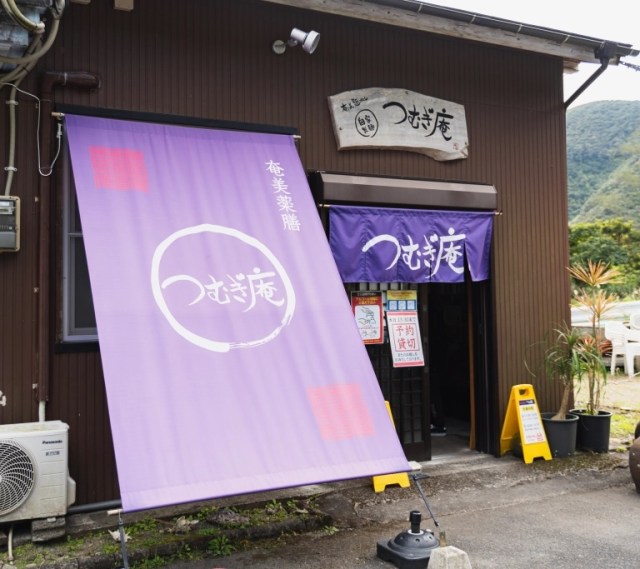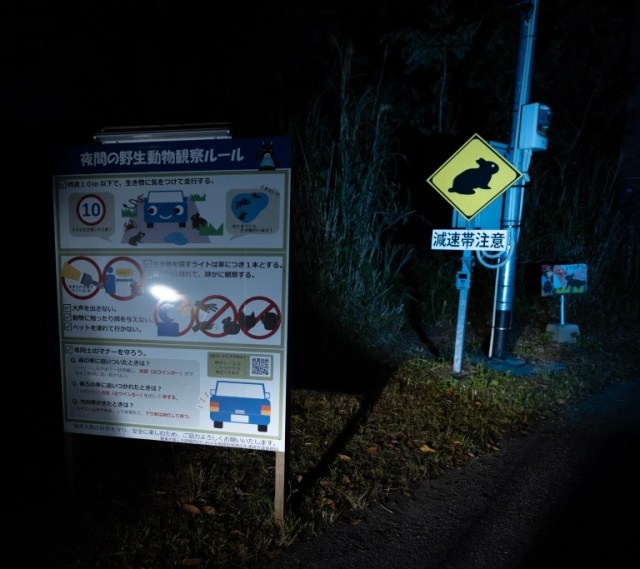
If you’ve been skipping Amami Oshima on your trips to Japan, you’ve been skipping a beautiful, uncrowded gem.
Kagoshima Prefecture is typically thought of as the southwestern corner of Japan’s southwestern island of Kyushu. However, Kagoshima also includes a number of islands that stretch even further away, with some being more than half-way to Okinawa.
Today, we’re headed to one of those islands: Amami Oshima.
▼ Amami Oshima
▼ Amami Oshima airport
We were invited to check out the island by the “Wide Area Administration Association of Amami Islands,” the local tourism promotion department. The highlight of our trip was to be a visit to the island’s mangrove forests, which conjured up primordial jungle imagery in our head, but things were surprisingly modern when we got out of the airport, with supermarkets, drug stores, and even a Family Mart convenience store not far away.
But as we hopped in our van and headed away from the airport, the scenery became increasingly lush…
…and before long, we were in a part of the island with such dense vegetation we weren’t sure we’d ever find our way back if we randomly wandered into it…
…and the view only got more beautiful once we reached the mangroves.
The trees grow in rivers and inlets where fresh and seawater mix, and we could see a meandering waterway in the middle of the forest we were approaching.
▼ The species of mangrove that grows on Amami Oshima is the bruguiera gymnorhiza, which you can tell from its flowers.
The mangroves are found in the Amami Gunto National Park Special Protection Zone, so you can’t just go traipsing off into the woods. Instead, we headed over to the Mangrove-kan (“Mangrove Building”)…
…which offers guided canoe tours.
Having zero canoe experience ourselves, we were sort of apprehensive about hopping into one. After a brief, five-minute safety and operation lecture, though, our group was on its way, and we quickly became accustomed to the rhythm of paddling our oars and gasping at the lovely landscape.
As we mentioned above, the mangroves grow in a mix of fresh and saltwater, and sometimes visitors will even encounter sea turtles while on the tour (we, unfortunately, weren’t lucky enough to, but a group that went out before us that day did). Tours are priced at 2,000 yen (US$15) and leave every 90 minutes between 10 a.m. and 4 p.m.
▼ A 360-degree view of part of the canoe route
By the way, if you’re looking for lunch at someplace with plenty of local flavor, near the Mangrove-kan is the restaurant Tsumugi-an. We treated ourselves to the 1,850-yen (US$14) manpuku (“full stomach”) set and stuffed ourselves with soba noodles, stewed pork, karaage fried chicken, tempura, and rice.
When night fell, instead of turning in early, we headed out once again for a special wildlife spotting tour.
To access this section of road after dark, visitors are required to make an advance reservation (which can be done online here). You also have to stay in your car and stay under a speed of 10 kilometers (6.2 miles) per hour.
But if you do all that…
…you’ve got a good chance of seeing the Amami no Kurousagi, or Amami Black Rabbit, a protected, and adorable, species.
Because of its geographic location, Amami Oshima often gets skipped over by travelers heading from the rest of Japan to further south in Okinawa. It’s a beautiful and unique place, though, so if you’re looking for something off the beaten path, it’s worth putting on your Japan travel itinerary.
Related: Amami Oshima Mangrove Park, Tsumugi-an
Photos © SoraNews24
● Want to hear about SoraNews24’s latest articles as soon as they’re published? Follow us on Facebook and Twitter!
[ Read in Japanese ]


















 What if we told you this badly Photoshopped image isn’t Photoshopped at all?
What if we told you this badly Photoshopped image isn’t Photoshopped at all? Daily Yamazaki convenience store’s “Flying in the Sky Donuts” are competition for Mister Donut
Daily Yamazaki convenience store’s “Flying in the Sky Donuts” are competition for Mister Donut Japanese gacha capsule vending machines now sell random-destination airplane ticket discounts
Japanese gacha capsule vending machines now sell random-destination airplane ticket discounts Samurai Studio: Tokyo’s new photo studio where you can get your picture taken in samurai armor
Samurai Studio: Tokyo’s new photo studio where you can get your picture taken in samurai armor Japanese resort travel company is offering exciting “revenge” graduation trips
Japanese resort travel company is offering exciting “revenge” graduation trips Japan’s new difficult-to-drink-from beer glass protects your liver, but it’s a brutal experience
Japan’s new difficult-to-drink-from beer glass protects your liver, but it’s a brutal experience How to order snacks on a Shinkansen bullet train in Japan
How to order snacks on a Shinkansen bullet train in Japan New samurai glasses are Japan’s latest weird must-have souvenir
New samurai glasses are Japan’s latest weird must-have souvenir “Deflowering” services for virgin women are now a thing in Japan, apparently
“Deflowering” services for virgin women are now a thing in Japan, apparently Doraemon found buried at sea as scene from 1993 anime becomes real life【Photos】
Doraemon found buried at sea as scene from 1993 anime becomes real life【Photos】 Burger King Japan suddenly adds Dr. Pepper and Dr. Pepper floats to its menu nationwide
Burger King Japan suddenly adds Dr. Pepper and Dr. Pepper floats to its menu nationwide Hello, cosmetics! Clinique teams up with Hello Kitty this summer for first-time collaboration
Hello, cosmetics! Clinique teams up with Hello Kitty this summer for first-time collaboration Princesses, fruits, and blacksmiths: Study reveals the 30 most unusual family names in Japan
Princesses, fruits, and blacksmiths: Study reveals the 30 most unusual family names in Japan High-fashion Totoro cuddle purse is like an elegant stroll in the forest【Photos】
High-fashion Totoro cuddle purse is like an elegant stroll in the forest【Photos】 Demon Slayer: Kimetsu no Yaiba gets new roller coaster attractions and food at Universal Studios Japan
Demon Slayer: Kimetsu no Yaiba gets new roller coaster attractions and food at Universal Studios Japan Nintendo history you can feel – Super NES, N64, and GameCube controllers become capsule toys
Nintendo history you can feel – Super NES, N64, and GameCube controllers become capsule toys “The most Delicious Cup Noodle in history” – Japan’s French Cup Noodle wins our heart【Taste test】
“The most Delicious Cup Noodle in history” – Japan’s French Cup Noodle wins our heart【Taste test】 Starbucks releases a cute Frappuccino and Unicorn Cake…but not in Japan
Starbucks releases a cute Frappuccino and Unicorn Cake…but not in Japan Kyoto Tower mascot termination reveals dark side behind cute Japanese characters
Kyoto Tower mascot termination reveals dark side behind cute Japanese characters McDonald’s Japan’s Soft Twist Tower: A phantom ice cream only sold at select branches
McDonald’s Japan’s Soft Twist Tower: A phantom ice cream only sold at select branches Yabai Ramen: What makes this Japanese ramen so dangerous?
Yabai Ramen: What makes this Japanese ramen so dangerous? Finally! Nintendo Japan expands Switch 8-bit controller sales to everybody, Online member or not
Finally! Nintendo Japan expands Switch 8-bit controller sales to everybody, Online member or not Japanese government wants to build luxury resorts in all national parks for foreign tourists
Japanese government wants to build luxury resorts in all national parks for foreign tourists To combat declining birth rate, Japan to begin offering “Breeding Visas” to foreigners
To combat declining birth rate, Japan to begin offering “Breeding Visas” to foreigners 10 things you should buy at 7-Eleven in Japan
10 things you should buy at 7-Eleven in Japan Studio Ghibli releases anime heroine cosplay dresses that are super comfy to wear
Studio Ghibli releases anime heroine cosplay dresses that are super comfy to wear Woman charged for driving suitcase without a license in Osaka
Woman charged for driving suitcase without a license in Osaka Studio Ghibli unveils My Neighbour Totoro miniature house model
Studio Ghibli unveils My Neighbour Totoro miniature house model Kyoto experiencing problems with foreign tourists not paying for bus fares, but not on purpose
Kyoto experiencing problems with foreign tourists not paying for bus fares, but not on purpose Fighting mild hunger with a Japanese soda that turns into jelly in the stomach【Taste test】
Fighting mild hunger with a Japanese soda that turns into jelly in the stomach【Taste test】 Studio Ghibli’s Howl’s Moving Castle tapestry unveiled in Japan for first time
Studio Ghibli’s Howl’s Moving Castle tapestry unveiled in Japan for first time McDonald’s new Happy Meals offer up cute and practical Sanrio lifestyle goods
McDonald’s new Happy Meals offer up cute and practical Sanrio lifestyle goods Sales of Japan’s most convenient train ticket/shopping payment cards suspended indefinitely
Sales of Japan’s most convenient train ticket/shopping payment cards suspended indefinitely Sold-out Studio Ghibli desktop humidifiers are back so Totoro can help you through the dry season
Sold-out Studio Ghibli desktop humidifiers are back so Totoro can help you through the dry season Japanese government to make first change to romanization spelling rules since the 1950s
Japanese government to make first change to romanization spelling rules since the 1950s Foreigner’s request for help in Tokyo makes us sad for the state of society
Foreigner’s request for help in Tokyo makes us sad for the state of society Ghibli founders Toshio Suzuki and Hayao Miyazaki contribute to Japanese whisky Totoro label design
Ghibli founders Toshio Suzuki and Hayao Miyazaki contribute to Japanese whisky Totoro label design Tokyo’s most famous Starbucks is closed
Tokyo’s most famous Starbucks is closed Where will you go this summer? Here are the top 10 Japanese swimming spots with the nicest water
Where will you go this summer? Here are the top 10 Japanese swimming spots with the nicest water Shippers rejoice! 10,000 anime fans pick their favorite same-sex pairings
Shippers rejoice! 10,000 anime fans pick their favorite same-sex pairings Tokyo Station lists departing train’s destination as…New York?!
Tokyo Station lists departing train’s destination as…New York?! Take a look at Tsunoshima Ōhashi, one of the most beautiful bridges in Japan! 【Pics】
Take a look at Tsunoshima Ōhashi, one of the most beautiful bridges in Japan! 【Pics】 Studio Ghibli theme park: New details include official park logo drawn by director Hayao Miyazaki
Studio Ghibli theme park: New details include official park logo drawn by director Hayao Miyazaki Leader of political party that refuses to pay NHK ordered to pay NHK
Leader of political party that refuses to pay NHK ordered to pay NHK Haneda Airport’s new rice ball stand — Sister shop Tokyo’s best out-of-the-way onigiri spot
Haneda Airport’s new rice ball stand — Sister shop Tokyo’s best out-of-the-way onigiri spot Joker in the running for Chiba Gubernatorial Election
Joker in the running for Chiba Gubernatorial Election Strong earthquake hits Hokkaido in Japan, dozens missing and injured
Strong earthquake hits Hokkaido in Japan, dozens missing and injured Samurai tennis! Professional Kei Nishikori trades racquet for a sword in this awesome new ad
Samurai tennis! Professional Kei Nishikori trades racquet for a sword in this awesome new ad Melon topped with ice cream: two great Hokkaido tastes in one crazily delicious package
Melon topped with ice cream: two great Hokkaido tastes in one crazily delicious package Slow News Day Special: We cook pasta with Tokyo Bay seawater
Slow News Day Special: We cook pasta with Tokyo Bay seawater Why are people moving in droves to Fukuoka Prefecture? We asked someone who did for some insight
Why are people moving in droves to Fukuoka Prefecture? We asked someone who did for some insight New Japanese vending machines to love: The ones that sell Hiroshima’s best dessert!
New Japanese vending machines to love: The ones that sell Hiroshima’s best dessert! Yokohama Air Cabin: A new futuristic ropeway in the middle of the city
Yokohama Air Cabin: A new futuristic ropeway in the middle of the city
Leave a Reply